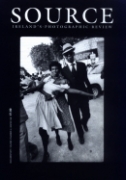Effort After Meaning
'Effort After Meaning' by Anselm Gallagher was at the Watershed Gallery, Bristol, 1997
Review by Anselm Gallagher
Issue 10 Winter 1997
View Contents ▸
There is a certain contradiction in offering contemporary colour photographs as personal memories, as Anselm Gallagher does in his eight square prints at Watershed in Bristol, as photographs are obviously contemporary, taken in the 'now'. One cannot photograph a memory.
The introduction to the work begins, "In an attempt to record memories of events and people from his childhood, Anselm Gallagher began to photograph a variety of objects and places around the area of Ireland where he grew up".
The majority of photographs, however, could well be taken as contemporary if not for the introduction. The images titled Father McGovern and Phyliss McTiernan both evoke a strong sense of personality. Father McGovern is a photograph of a silver kettle, lit by sunlight through a window. The juxtaposition of name and the kettle, conjure up images of cosy cups of tea and friendly advice. Phyliss McTiernan is a dark shot of almost black wallpaper. Barely visible is an equally dark, ornate crucifix on a wall, a small point of light shining from the bottom of the cross implies danger. This dark, oppressive picture suggests a woman living with 'the fear of God'. These ingenious 'portraits' could well concern characters who are alive today, they contain no obvious reference to the photographer's childhood. Phyliss McTiernan was, we are told in the increasingly superfluous introduction, Anselm Gallagher's babysitter. This direct information adds nothing to a picture that already evokes an intimate emotional understanding of it's subject. Her connection to the photographer is irrelevant. The idea of childhood memory is only evoked in one photograph, Christmas Cake, where a rusting, disconnected cooker, stands in the corner of a run-down kitchen. The associations of Christmas and childhood and a cake long since baked and eaten.
The colours within the photographs are very subtle, apart from the odd highlighted detail; the red light in Phyliss McTiernan. The majority of the photographs contain areas of blackness, underlining the viewer's search for answers to the questions posed by the seemingly contradictory title of each work; Tom in New York is a view into a dark, disused shed, did Tom abandon his farm for the New World? Seamus' New Bungalow has a rusted end of a car up against an old washing machine or cooker. There is nothing 'new' in the picture. With some the questions are too great, the references too obscure, too personal to the artist, for us to even begin to decipher; Fair Day and Gerard's Big Tit were indecipherable to this viewer.
The use of near focus, having the nearest point of the image in focus, and letting the background fall out of focus, tends to push the viewer away from the image, and as we explore beyond what's presented in the foreground there is a sense the viewer has of intrusion, which only adds to the personality, and personalisation, of the stronger images.
Revisiting his own childhood may well have been Anselm Gallagher's initial motivation for this series of intriguing photographs, but as a whole the images themselves contain few obvious references to this. They are more powerful in their own individual personalities and do not need the written, intellectualised justification that so many modern artworks rely on.
Other articles mentioning Anselm Gallagher:
Other articles on photography from the 'Portraiture' category ▸






